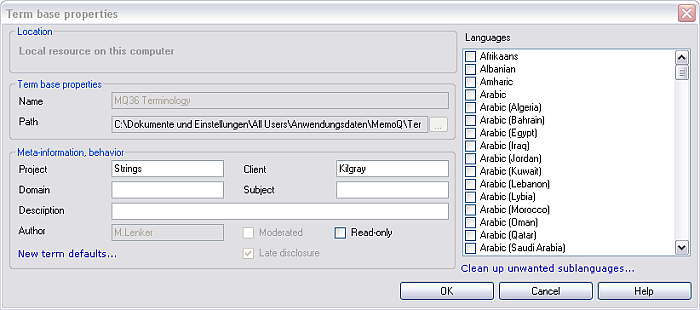|
The Term base properties dialog allows you to change the properties of an existing term base.
How to beginYou can invoke this dialog by clicking the Properties command at the following locations: •the Term bases dialog of the New memoQ project wizard •the Term bases pane of Project home (on the Term Bases ribbon tab) •the Term bases pane of the Resource console •the term base editor. In the list of term bases, select the term base, and then click Properties below the list. Alternatively, right-click the term base, and choose Properties. In the term base editor, click the Properties button on the Term Bases ribbon tab. Alternatively, choose Properties from the Term base menu. OptionsThis dialog has four sections: Location, Term base properties, Meta-information, behavior, and Languages. Location section: This section displays the location where the selected term base is located (on your computer, on a server, or the term base is a local copy of an online term base). Term base properties section: This section displays properties of the selected term base. You cannot change these items. •Name: This field indicates the name of the term base. •Path: This field indicates the full name of the folder where the term base is stored. Meta-information, behavior section: This section allows you to change the meta-information items for the selected term base and to filter your term base for these meta-information. •Project: Use this field to enter the project identifier. •Client: Use this field to enter the client identifier. •Domain: Use this field to enter the domain of the term base. •Subject: Use this field to enter the subject of the term base. •Description: Use this field to enter a description of the term base. •New term defaults... link: Click this to open the New term defaults dialog where you can set up default properties such as case sensitivity, prefix matching, and others for any new entries in the term base. Important: Words in the meta-information fields project/domain/client/subject are searched separately. For example when you enter (aa bb) then all terms with fields being (aa) or (bb) are found. A term with (aa aa) will not be found. If you only enter ("aa bb") in the filter dialog then only terms are found which have (aa bb) as value. You cannot change the following items: •Author: This field indicates the creator of the term base. •Moderated: This check box indicates whether you want this term base to be moderated, i.e. terminologists will need to approve any new entries. •Read-only: Check this check box to indicate that the term base is not writable. memoQ will not save nor import terms into the term base. •Late disclosure: In case of moderated term bases, if this check box is checked, new term base entries will only appear to other server users when the moderator has confirmed the entries. This is the default setting. If not checked, new term base entries will immediately appear to every server user. Languages section: This section shows languages supported by the term base. For example, if you are translating from French to German, you can use a term base where French and German are checked in the list, utilizing the terminology contained in this term base and adding new expressions as needed. However, you may also receive a term base for languages that differ from one you are translating to. In this case, you can extend the term base to cover your language, too. To add a new language, simply check the corresponding item in the language list. Note: You cannot remove main languages that existed in the term base when you invoked this dialog. You can clean up unwanted sublanguages. NavigationClick OK to close the dialog and save changes to the term base. Clicking Cancel will close the dialog without making changes. |
